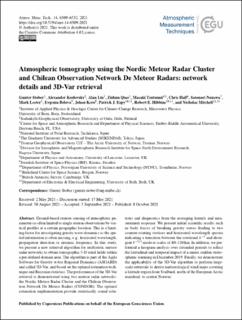| dc.contributor.author | Stober, Gunter | |
| dc.contributor.author | Kozlovsky, A. | |
| dc.contributor.author | Liu, Alan | |
| dc.contributor.author | Qiao, Zishun | |
| dc.contributor.author | Tsutsumi, Masaki | |
| dc.contributor.author | Hall, Chris | |
| dc.contributor.author | Nozawa, Satonori | |
| dc.contributor.author | Lester, Mark | |
| dc.contributor.author | Belova, Evgenia | |
| dc.contributor.author | Kero, Johan | |
| dc.contributor.author | Espy, Patrick Joseph | |
| dc.contributor.author | Hibbins, Robert E. | |
| dc.contributor.author | Mitchell, N. | |
| dc.date.accessioned | 2021-11-16T12:48:17Z | |
| dc.date.available | 2021-11-16T12:48:17Z | |
| dc.date.created | 2021-11-02T22:53:44Z | |
| dc.date.issued | 2021 | |
| dc.identifier.citation | Atmospheric Measurement Techniques. 2021, 14 (10), 6509-6532. | en_US |
| dc.identifier.issn | 1867-1381 | |
| dc.identifier.uri | https://hdl.handle.net/11250/2829851 | |
| dc.description.abstract | Ground-based remote sensing of atmospheric parameters is often limited to single station observations by vertical profiles at a certain geographic location. This is a limiting factor for investigating gravity wave dynamics as the spatial information is often missing, e.g., horizontal wavelength, propagation direction or intrinsic frequency. In this study, we present a new retrieval algorithm for multistatic meteor radar networks to obtain tomographic 3-D wind fields within a pre-defined domain area. The algorithm is part of the Agile Software for Gravity wAve Regional Dynamics (ASGARD) and called 3D-Var, and based on the optimal estimation technique and Bayesian statistics. The performance of the 3D-Var retrieval is demonstrated using two meteor radar networks: the Nordic Meteor Radar Cluster and the Chilean Observation Network De Meteor Radars (CONDOR). The optimal estimation implementation provide statistically sound solutions and diagnostics from the averaging kernels and measurement response. We present initial scientific results such as body forces of breaking gravity waves leading to two counter-rotating vortices and horizontal wavelength spectra indicating a transition between the rotational k−3 and divergent k−5/3 mode at scales of 80–120 km. In addition, we performed a keogram analysis over extended periods to reflect the latitudinal and temporal impact of a minor sudden stratospheric warming in December 2019. Finally, we demonstrate the applicability of the 3D-Var algorithm to perform large-scale retrievals to derive meteorological wind maps covering a latitude region from Svalbard, north of the European Arctic mainland, to central Norway. | en_US |
| dc.language.iso | eng | en_US |
| dc.publisher | European Geosciences Union | en_US |
| dc.rights | Navngivelse 4.0 Internasjonal | * |
| dc.rights.uri | http://creativecommons.org/licenses/by/4.0/deed.no | * |
| dc.title | Atmospheric tomography using the Nordic Meteor Radar Cluster and Chilean Observation Network de Meteor Radars: Network details and 3D-Var retrieval | en_US |
| dc.type | Peer reviewed | en_US |
| dc.type | Journal article | en_US |
| dc.description.version | publishedVersion | en_US |
| dc.source.pagenumber | 6509-6532 | en_US |
| dc.source.volume | 14 | en_US |
| dc.source.journal | Atmospheric Measurement Techniques | en_US |
| dc.source.issue | 10 | en_US |
| dc.identifier.doi | 10.5194/amt-14-6509-2021 | |
| dc.identifier.cristin | 1950801 | |
| cristin.ispublished | true | |
| cristin.fulltext | original | |
| cristin.qualitycode | 1 | |

